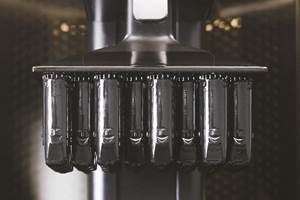Additive Manufacturing: Front and Center at SPE’s ACCE
Ford discusses Carbon3D's layerless 3D printing technology.
Share
It was all about automotive and design during the Society of Plastics Engineers (SPE) Automotive Composites Conference and Exhibition (ACCE) that took place last week in Novi, Michigan. The conference had three different tracks full of technical papers on a wide range of topics as well as several keynote speakers. They even had the very cool BMW i8, which features carbon-fiber-reinforced plastic, on full display. While there was plenty to digest at the show, one of the tracks that really stuck out to me was the one on additive manufacturing.
Perhaps showing its growth in the automotive market, this was the first year for SPE ACCE to feature a track specifically dedicated to additive manufacturing/3D printing.
Ellen Lee, materials and manufacturing research for Ford, Dearborn, Michigan), said that while additive manufacturing isn’t new for the automaker (almost 30 years of experience), the company is focused on going beyond the prototype level to the direct production of end use, functional parts. Recently, the company developed a dedicated new additive manufacturing research program to explore the potential of new technologies to manufacture vehicle-ready parts.
Also, Ford has partnered with Silicon Valley startup Carbon3D on using the company’s Continuous Liquid Interface Production (CLIP) technology. In December 2014, Ford began testing a pre-release version of Carbon3D’s first CLIP-based device. The company says that Carbon3D’s CLIP technology is allowing it to move more quickly from ideas to production. The automaker has already successfully applied the technology to current and future vehicle model designs, and is leveraging CLIP to research new automotive relevant materials.
Carbon3D’s CLIP technology uses a tunable photochemical process instead of the traditional mechanical approach, which is said to eliminate the “shortcomings of conventional layer-by-layer 3D printing technology,” to rapidly transform 3D models into physical objects. CLIP carefully balances the interaction of UV light, which triggers photo polymerization, and oxygen, which inhibits the reaction, allowing for continuously grown objects from a pool of resin. These predictable mechanical properties allow for part creation across the range of needs for Ford vehicles including under the hood, interiors and high strength to weight ratio parts.
Beyond the current vehicle applications, Ford has also been able to expand its own materials research because of CLIP’s gentle process and dedication to high quality polymeric materials. To date, the team has tested several materials including resins reinforced with nano-sized particles. Ford says its eager to further investigate resin modifications for improved mechanical properties and consider the creation of thermally and electrically conductive materials for future vehicle applications.
Looking toward the future, Lee said that one of the main challenges of additive manufacturing for automotive is limited materials as many materials currently available are not suitable for automotive applications. “The future direction for us is materials development and understanding how we can customize them,” she said.
“It’s nice to see automotive embrace additive manufacturing, since our requirements are more unique than medical and aerospace,” Lee said. “We believe additive manufacturing will significantly impact automotive manufacturing and Ford wants to be involved and also help direct where it goes.”
There are plenty more topics of interest from thermoplastics to recycling, and of course, more additive manufacturing, so be sure to check out my full conference overview in the November issue of Plastics Technology magazine.
Related Content
What is Powder Bed Fusion 3D Printing?
Whether in metal or polymer, with a laser or an electron beam, powder bed fusion (PBF) is one of the most widely used 3D printing techniques.
Read MoreAM 101: Digital Light Synthesis (DLS)
Digital Light Synthesis (DLS) is the name for Carbon's resin-based 3D printing process. How it works and how it differs from stereolithography.
Read MoreAirless Basketball Shows Promise of 3D Printed Lattices: The Cool Parts Show Bonus
Successfully matching the performance of a standard basketball demonstrates the control possible over the mechanical properties of digital materials.
Read MoreSolving 3D Printing’s Hidden Problem: Vibration
Ulendo’s vibration compensation software can double the speed of FFF 3D printers while maintaining part quality, all without changing the machine’s hardware.
Read MoreRead Next
3D Printing Brings Sustainability, Accessibility to Glass Manufacturing
Australian startup Maple Glass Printing has developed a process for extruding glass into artwork, lab implements and architectural elements. Along the way, the company has also found more efficient ways of recycling this material.
Read MoreHybrid Additive Manufacturing Machine Tools Continue to Make Gains (Includes Video)
The hybrid machine tool is an idea that continues to advance. Two important developments of recent years expand the possibilities for this platform.
Read More4 Ways the Education and Training Challenge Is Different for Additive Manufacturing
The advance of additive manufacturing means we need more professionals educated in AM technology.
Read More





















